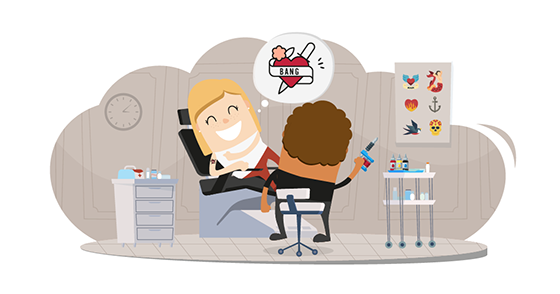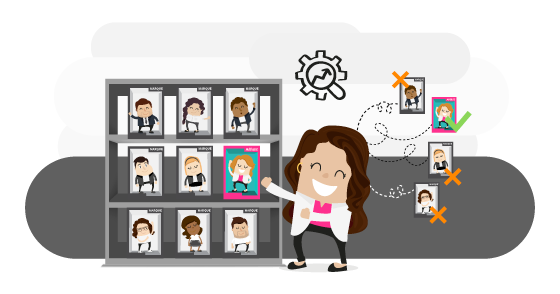How to improve employee engagement in your company?
Oct 22 2019 / 7 min

Engagement isn’t just about improving your reach on Facebook! It’s a factor being talked about increasingly in HR marketing, and it makes all the difference to the effectiveness of your employer brand and the opportunity to ensure employee satisfaction!

What is employee engagement and its importance, you ask? Here’s a quick definition.
Employee commitment to your organization is akin to a sense of belonging. It goes beyond tasks and responsibilities; it’s about the bonds they forge with their work, colleagues, and the company’s essence. It’s the heart they put into their work and their pride in being part of the group. This sense of belonging creates a ripple effect throughout the organization, radiating to customers, partners, and stakeholders. It nurtures a culture of loyalty, collaboration, and trust, transforming the workplace into a dynamic ecosystem where individuals flourish, and collective achievements are celebrated.
Who wouldn’t want to boost engagement levels in the office? After all, the impact of the opposite is undeniable.
Did you know? Replacing an employee can cost up to 250% of their salary!*
From a marketing point of view, this statistic is disastrous! Disengagement erodes productivity, stifles innovation, and undermines the organization’s fabric. Conversely, a highly engaged workforce becomes a tremendous asset, fueling growth, promoting customer satisfaction, and propelling the company to success. The more engaged your crew, the healthier your employer brand becomes – the opportunity to become an irresistible magnet for top talent and an embodiment of excellence in the eyes of your stakeholders.
It’s time to put an action plan in place!
Why are employee engagement strategies important?
Engagement is a vital factor for a thriving business and having employee engagement strategies in place is crucial. When employees are engaged, they are emotionally connected and fully committed to their work and the organization’s goals. Motivated and productive, they go the extra mile to contribute to the company’s success. People are more likely to stay with the organization and achieve their goals, reducing turnover and associated costs. In addition, engaged employees tend to be more satisfied with their work, which translates into higher morale and positive work culture. They become advocates for the company, promoting its brand and helping to attract top talent. Overall, their engagement fosters a sense of loyalty, collaboration, and innovation, creating a high-performance environment where teams and the organization can flourish.
Engaging your current employees and attracting talent
The link between these two aspects of human resources isn’t evident to everyone, but they’re part of the same cycle in HR marketing.
As we’ve discussed, traditional advertising no longer has the same effect on the public as it once did. In the digital age, people are savvy and much prefer the opinion of real humans to the rhetoric of publicists. Whether buying a dryer or finding your next job, the reality is the same.
The opinions of friends and colleagues are among the most important sources of information for jobseekers, both for finding opportunities and for validating the reputation of companies**.
Therefore, your employees’ voice significantly impacts attracting new talent. The fact that they enjoy their working environment and are proud to work for you means they are likelier to recommend you as an employer. If you give these employees a voice, they become ambassadors for your employer brand—a key influencer whose opinions can have power over your current team and candidates.
Internal communication and content marketing for workplace engagement
Among the myriad factors influencing employee satisfaction and overall engagement in the workplace, certain elements have always been essential, such as salary, benefits, and work-life balance. However, in an ever-changing landscape, one aspect, particularly, is gaining importance within organizations: the work atmosphere. This powerful force encompasses the collective interactions, attitudes, and relationships that shape employees’ day-to-day experiences. A positive work atmosphere fosters a sense of belonging, camaraderie, and purpose, creating fertile ground for productivity and commitment to flourish.
It is within this dynamic ecosystem that recognition is an essential pillar. Appreciating people’s contributions, achievements, and efforts is the foundation of a solid corporate culture. By celebrating successes, highlighting outstanding performance, and nurturing this culture, companies boost employee morale and motivation and foster a deep sense of loyalty and commitment. Businesses can proactively shape the working atmosphere through effective internal communication and strategic content marketing initiatives, reinforcing their values and driving workplace engagement to new heights.
How do you increase (and maintain) employee commitment? By making them feel valued and engaged.
The most engaged employees on a team are generally those who understand the importance of their role in the company’s success. Your HR marketing strategy can help you foster this sense of commitment. Here are a few ideas for an action plan to increase adherence to your employer brand.
- Publish portraits. On your intranet or social media, share a post once a month featuring a team member, their role, and achievements. These portraits will generate pride while giving a human voice to your communications. They can also solidify your expert status in your customers’ eyes as they showcase your team’s and talents. Consider asking your managers to share and comment with pride on these micro-contents.
- Involve your colleagues in content production. Whether writing an article, shooting an expert clip, recommending an employee to celebrate, or suggesting new ideas, this collaboration will provide you with the material while making the team feel heard! However, ensure that the communication channels are clear: if the most enthusiastic don’t see their efforts come to fruition, their commitment will quickly wane.
- Pass the microphone to different groups of employees. When discussing a completed project, a success story, an upcoming change, or a new partnership, the management’s grain of salt is essential. But including a quote from a project manager, adding a photo of the teams in the field, or presenting a colleague’s opinion makes your messages more lively.
- Regular communication channels. Establish open and transparent communication channels to keep employees informed and engaged. These include regular team meetings, town hall meetings, newsletters, and intranet platforms. Updating company news, progress, and upcoming initiatives fosters a sense of belonging and involvement.
- Recognition programs. Implement formal or informal recognition programs to acknowledge and appreciate your employees’ contributions. These may include peer recognition, an employee of the month or year awards, or appreciation events. Recognizing and celebrating achievements motivates, boosts morale, and reinforces a culture of appreciation. It will drive employees to do their best work.
- Professional development opportunities. Invest in developing your talent by offering training programs, workshops, or mentoring opportunities, depending on their needs. Offering professional development opportunities enhances employees’ skills and demonstrates a commitment to their long-term success and career progression. This initiative fosters engagement by encouraging a learning culture and showing that the company values the development of its employees.
- Well-being and work-life balance. Prioritize employee well-being by encouraging work-life balance initiatives. These may include flexible working arrangements, wellness programs, employee assistance programs, or initiatives promoting physical activity and mental health. Supporting employees’ health and work-life balance is key and increases job satisfaction and commitment.
- Listen and act. Take the time to put survey mechanisms in place to identify your employer brand’s strengths and shortcomings to correct them. Listening to your employees’ opinions, ideas, and concerns shows their voice is valued. Acting on feedback and involving them in decision-making develops engaged employees by fostering a sense of belonging and commitment.
- Team-building activities. Organize team-building activities and social events to cultivate strong relationships between employees. These can include retreats, team outings, or volunteer opportunities. Building a sense of camaraderie and collaboration strengthens teamwork, communication, and overall commitment within the organization.
Can we measure employee engagement and the benefits of employee engagement?
The concept of engaged employees may seem difficult to quantify, but its impact can be measured and understood. Just as a conductor reads the rhythm of a symphony, businesses can use various tools and strategies to take the pulse of employee engagement.
How do you measure employee engagement? Employee engagement surveys and more…
Various methods and tools can be used to measure engagement within your teams. Here are a few approaches you might consider using in your organization.
- Employee engagement surveys. Employee engagement surveys are a must! They can include questions on job satisfaction, motivation, sense of belonging to the company, internal communication, etc. The answers will provide quantitative and qualitative data to assess overall employee engagement. You can produce your internal surveys or use proven technological tools to take the pulse of your resources.
- Performance dashboard. Identify and track key performance indicators (KPIs) specific to employee engagement, such as turnover rate, the retention rate of new staff, absenteeism, voluntary overtime, employee engagement index, etc. These metrics, compiled in a digital dashboard and updated regularly, will give you a good idea of how engaged your talent is in their work.
- Individual interviews. Regular meetings between employees and their manager (or HR team) can be an opportunity to discuss their level of engagement. You can ask open-ended questions about their motivation, career aspirations, concerns, etc. These discussions can provide deeper insights into individual employee engagement. Consider building a checklist for your managers or commission members of your HR team. This approach will have the advantage of facilitating neutral exchanges.
- Employee feedback. Set up mechanisms and communication channels to regularly gather feedback from your talent, such as suggestion boxes or brainstorming sessions. Encourage employees to give feedback on their engagement. They can provide ideas, suggestions, and comments on aspects of the company that influence their engagement.
By listening carefully to employees’ voices, organizations can decipher the melodies of satisfaction, identify areas for improvement, and fine-tune their practices to foster a more engaged workforce. These measures serve as benchmarks for continuous improvement, aligning the organization’s collective heartbeat with its goals and aspirations, helping employers put their best work forward for their employees.
Authenticity: the secret to effective employee engagement
Whatever initiatives or new ideas you put in place to find ways of engaging employees within your organization, remember that the most important thing is to make your employees feel part of a close-knit team – this is your opportunity to show them that they play a crucial role in the company’s success. By fostering a culture of inclusion, trust, and open communication, you can enable your employees to give their best at work every day.
- Recognize and value their contributions
- Provide opportunities for growth and development
- Foster a sense of camaraderie and collaboration.
You’ve got it: when employees and managers feel connected to their work, colleagues, and the company’s mission, they become ambassadors, driven to exceed expectations and deliver exceptional results.
And if you need a hand implementing an action plan, structuring new ideas, or creating compelling HR marketing content, our team of experts is here to help.
We understand the importance of employee engagement and have the knowledge and experience to help you develop effective strategies and initiatives tailored to your unique organizational culture. We can create an engaging workplace where employees thrive, innovation flourishes, and the company succeeds.
* According to Bleexo
** According to Randstad’s Employer Brand Research 2019
You may also like

How do you attract customers and candidates? With the right marketing positioning!
It’s no secret: your products or services are unrivalled on the market! But are your potential customers awar[...]
Strategy
Nov 19, 2024
/5 min

How much should I spend on marketing?
Marketing is essential to building awareness of your brand and products and maximizing your revenues. But how do yo[...]
Strategy
Dec 19, 2023
/5 min

Define your customer journey
Did you know? In urban planning, desire paths are paths that have been gradually eroded by the repeated passage of [...]
Strategy
Aug 23, 2022
/4 min
